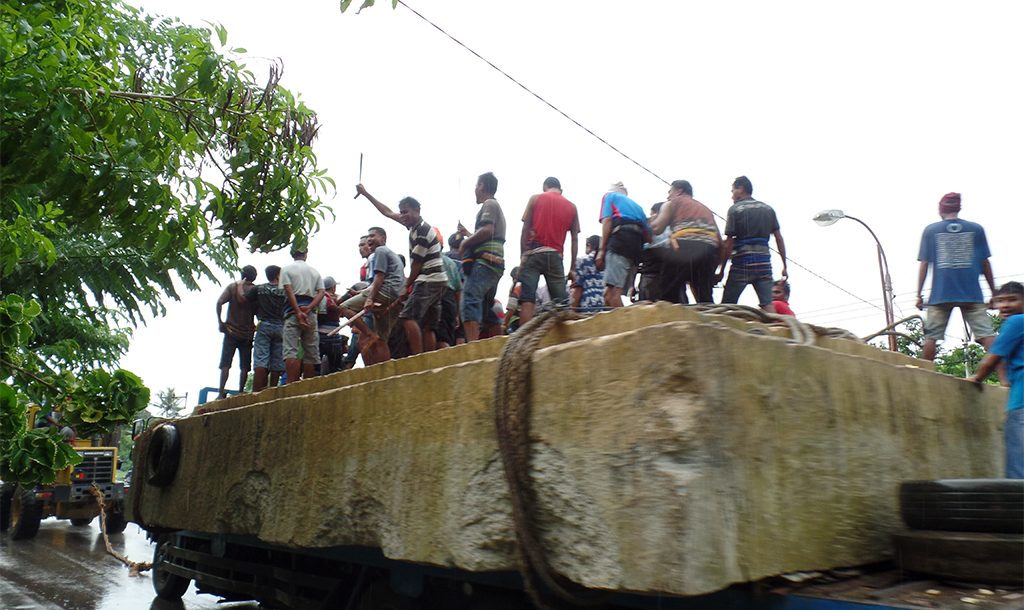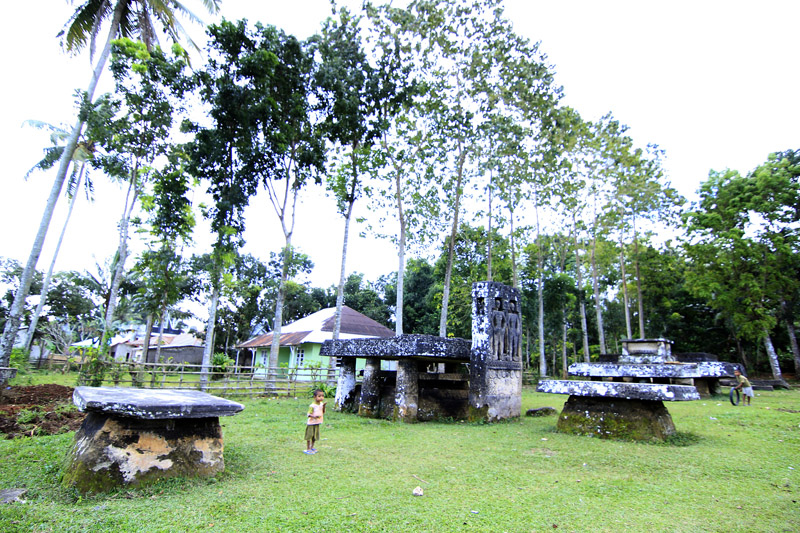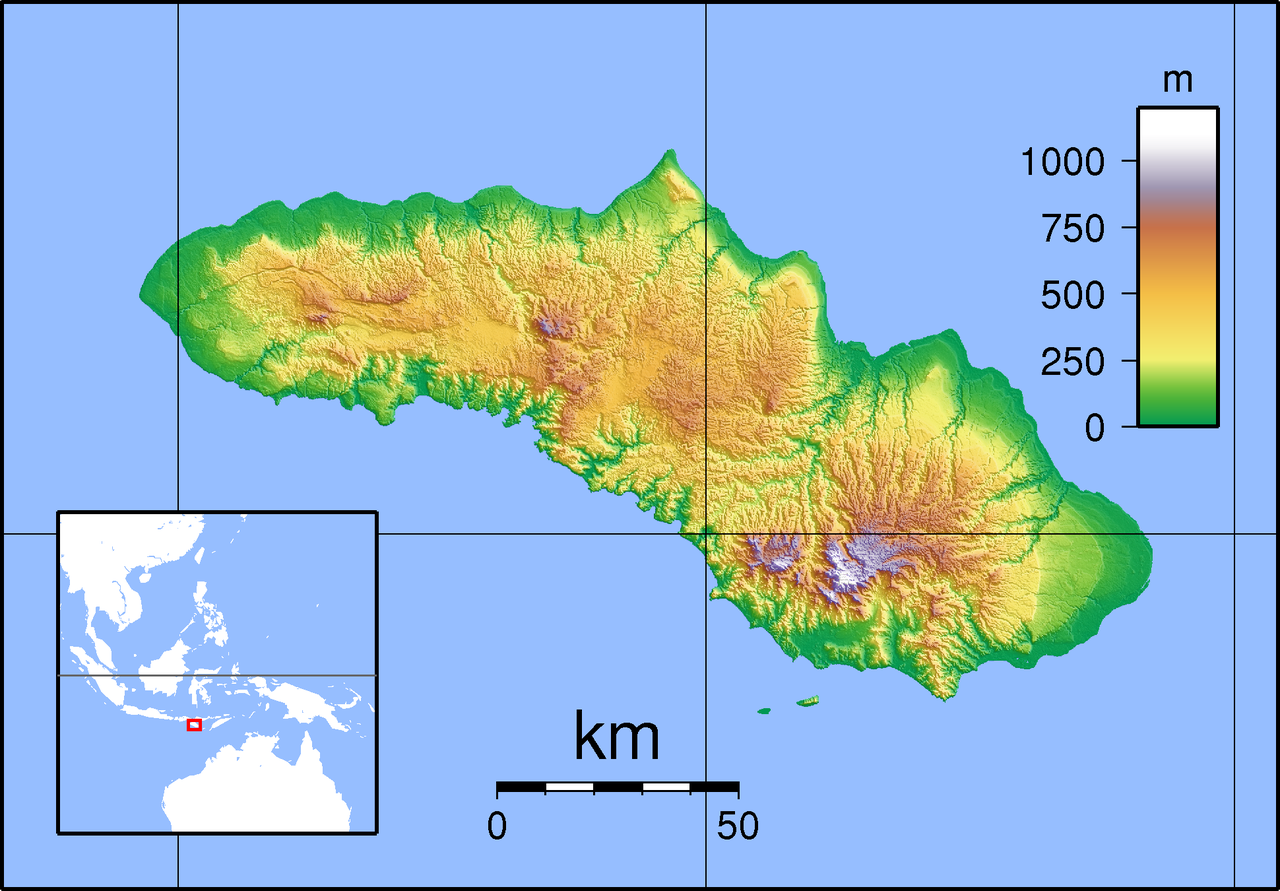Jacqueline Vel takes a look at the revival of an extravagant and outdated burial tradition in eastern Indonesia, and why it may be a worrying sign for local democracy.
“What’s up in Central Sumba?” I asked friends in Waibakul, the capital town of the Indonesian regency when I visited them in December 2016.
“Someone is dragging a stone!” they replied.
The expression refers to a huge tomb stone that is carved from rocks and then ‘dragged’ to the kampong of the person for whose grave it will be used. In the past, dragging was the joint effort of thousands of men. Today, a truck will transport the stone for the larger part of the journey. So the question is, why would anyone drag a stone in 2016?
Stone dragging anno 2016
Stone dragging is a customary activity that gives a grave occupant a huge tombstone and a grand reputation. Anthropologist Janet Hoskins explained that the peculiar thing about stone dragging in Sumba (in contrast to other areas in Indonesia and the world) is that “prominent men do not need to rely on the willingness of their relatives to construct large graves for them after their deaths”.
“They can instead sponsor stone-dragging ceremonies themselves. In this way, several years or even decades before their death they may assure themselves of a prestigious grave and the enduring renown of a great feast giver,” she writes.
Stone dragging has become rare. Most people in Sumba nowadays construct modern style graves with tombstones made with cement. Size and finishing still show status differences, with large ceramic tile lined graves seen as the pinnacle of modern style.
Such modern graves are more practical because their construction will not involve as many people as stone dragging. Moreover, stone dragging is associated with the local Marapu religion, whereas the vast majority of Sumbanese are now Protestant Christian or Catholic.
When I asked about the stone dragging, I was told that the person in charge of the huge event was Umbu Neka Jarawoli — the chairman of the district parliament in Central Sumba and member for the Democratic Party (Partai Demokrat). It would seem that stone dragging has become the bedrock of his politicking.
In November 2016 he started his stone dragging operations. He brought a truck from Java that was strong enough to carry the largest tomb stone ever. It cost him 175 million rupiah (roughly US$13,000) local rumour said.
Umbu Neka’s large stone dragging event ignored the incumbent district head’s main policy over the last nine years, summarised in his three “moral guidelines” for the local population: one, grow your own food; two, use natural resources with care, and in particular refrain from excessive livestock slaughtering; and three, make our villages a safe place to live again.
Umbu Neka’s stone dragging violates the second of these guidelines, because every day during the carving and dragging many heads of livestock and pigs were slaughtered to provide workers with meals. In Sumba livestock has important symbolic value. Slaughtering pigs, horses and water buffalo is a traditional way by which men underscore their social status: the more animals, the higher the status. In the past this was common practice in this area in Central Sumba — and it still is despite the government’s efforts to limit the slaughtering.
On the same day in December while I was visiting my friends in Waibakul, Umbu Neka’s procession with the stone passed by. In the parade were perhaps a thousand motor cycles, and it seemed like every single car, bemo or truck in Central Sumba had been mobilised to escort the stone on its way to the kampong. Engines roared, sirens blared, and troops yelled fanatically. There was aggression in the air, as if those in the parade were heading off to war.
Stones and local politics
Why would Umbu Neka do this? Why would he drag such a big stone in 2016, and in a district where the vast majority of people are Christian? Why would a modern, well-educated man revert to what could be considered an outdated tradition? The short answer is that dragging a stone brings huge publicity.
Such an event means that everyone in the district will know his name; everyone who joined the parade will feel part of a movement, and included. Umbu Neka used the event to create enduring renown as a great feast giver, and by association the reputation of a great traditional leader who is able to mobilise the masses.
All this supports Umbu Neka’s political ambitions. He announced that he is planning to run for the office of district head in the next general elections taking place in 2017. The media picked up the event. On 12 December 2016 the national broadcasting station Andalas television (ANTV), owned by the Bakri Group, broadcast footage from it.
What we see happening here is a local prominent man mixing traditional and modern means and symbols as part of his strategy to obtain the office of district head. This office is very important in Sumba, because it is the most powerful position in providing access to state resources like subsidies and employment opportunities, of which more than 90 per cent derives from the national government.
The challenge for election candidates is to appeal to the citizens of Central Sumba. Traditional means might then be an effective way of gaining votes. Stone dragging is a tradition of the era of local kingdoms, and Umbu Neka’s event referred to the past of Anakalang, a major kingdom located around what is now Central Sumba’s capital town.
Such reference appeals to people’s identity as belonging to the clans united in this kingdom. Those clans were hierarchical and prominent men would handle relations with other clans and politics with outside parties. A consequence of stimulating such local patriotism is that voters in general elections will be more inclined to elect their traditional patrons.
That is a worrying prospect for the quality of local democracy.
Jacqueline Vel is researcher at the Royal Netherlands Institute of Southeast Asian and Caribbean Studies (KITLV) and the Van Vollenhoven Institute, Leiden Law School.
 Facebook
Facebook  Twitter
Twitter  Soundcloud
Soundcloud  Youtube
Youtube  Rss
Rss 

